Table of Contents
Cyclone Wojtyla in the Windy City
John Paul II Visits Quigley South
And Now, Pope John Paul II Comes to Us
Click on images to see them at a larger resolution.
Table of Contents
Cyclone Wojtyla in the Windy City
John Paul II Visits Quigley South
And Now, Pope John Paul II Comes to Us
Click on images to see them at a larger resolution.
For many, the pope is the human face of the Church, instantly recognizable to almost any Catholic. A pontiff’s picture is always found within a parish rectory, church sacristy, or school office. But how often do you have the opportunity to meet the pope? Some may travel to Vatican City, while others may attend World Youth Day. But unless you live in Rome, it is unlikely that you would find the Holy Father coming down your street.
However, if you were in Chicago in October of 1979, you saw exactly that. 40 years ago, Pope John Paul II came to the city of Chicago—an extraordinary event which saw an outpouring of devotion and excitement throughout the city. John Paul II’s visit affected not only Catholics. City government, local businesses, and faith leaders came together in a display of unity and cooperation. At the ground level, hundreds of thousands thronged familiar streets, parks, and churches to catch a glimpse, or hear a word from the vicar of Christ.
On the 40th anniversary of St. John Paul II’s historic trip to Chicago, the Joseph Cardinal Bernardin Archives and Records Center has selected material from our collections to bring you back in time to that incredible weekend—when the Pope walked the streets of our city.
Pope John Paul II (born Karol Wojtyla in 1920) was not the first pope to visit the United States—that distinction would go to Pope Paul VI in 1965. Nor was it the first time Wojtyla had come to Chicago. Karol, who was made a bishop of Krakow in 1958 and a cardinal in 1967, traveled to the Windy City previously in 1969 and 1976, visiting Chicago’s Polish neighborhoods.
When Cardinal Wojtyla was elected pope on October 16, 1978 and took the name John Paul II, he—the first non-Italian Pope in nearly 500 years, and the youngest (58) in over a century—began planning extensive travels throughout the world. Four months into his papacy, John Paul II took his first trip to the Caribbean and Mexico. In June of 1979, he traveled to Poland, drawing millions despite the pressure from the Soviet-backed Communist regime. The Pope’s energy and activity earned him the nickname “Cyclone Wojtyla” in Rome.
In July of 1979, John Paul II announced his intention to visit the United States and tour several American cities. The Archbishop of Chicago, John Cardinal Cody extended an open and eager invitation for the Holy Father to visit his flock in the Midwest. The Holy Father’s decision to visit to the Windy City was not by chance. At the time, the Archdiocese of Chicago was the most populous diocese in the United States; furthermore, Chicago contained the largest population of Poles outside of Poland.

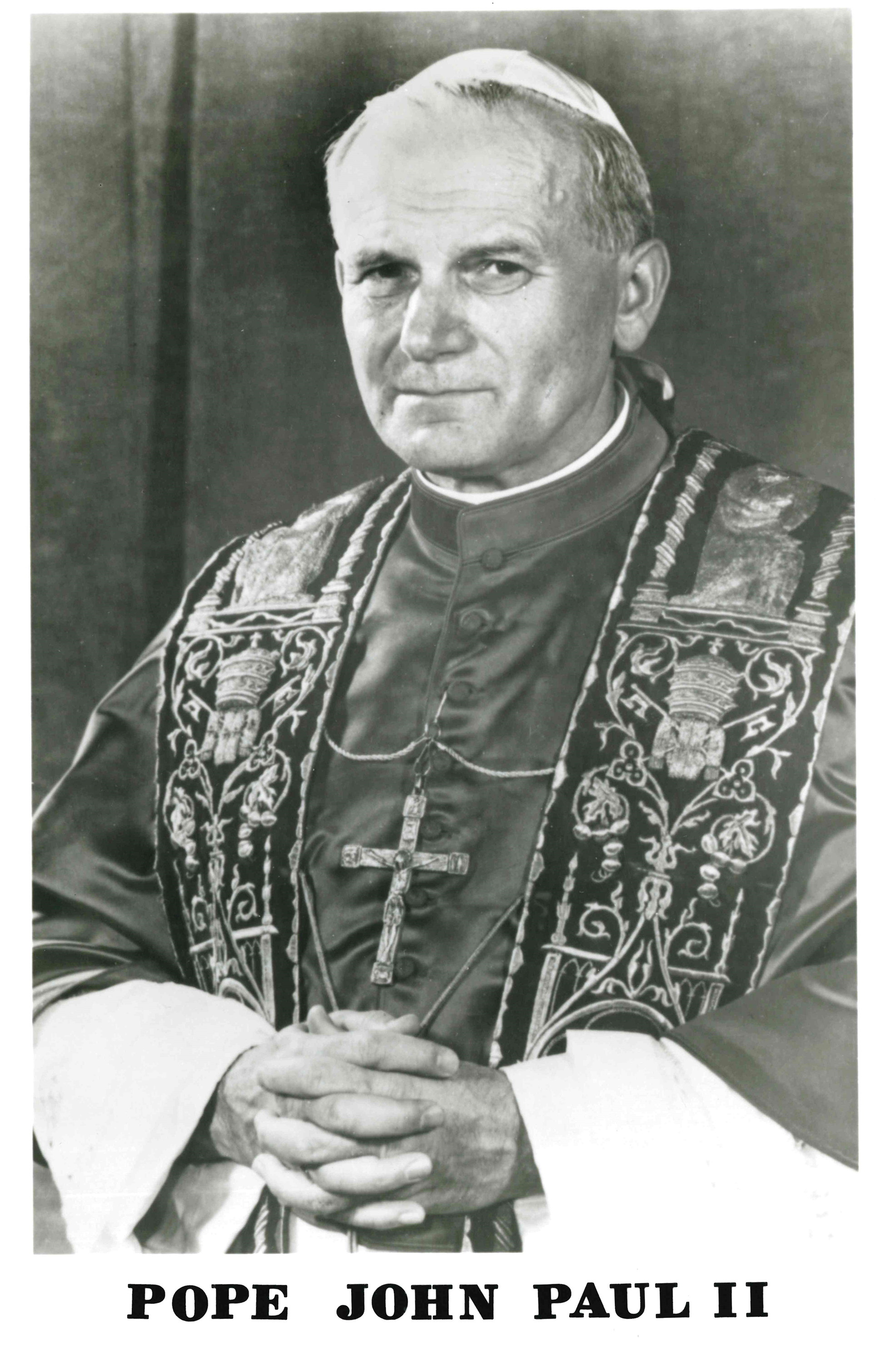
With a mere 21 weeks to prepare for the Pope’s visit, both the city and the Archdiocese scrambled to provide the necessary accommodations, not only for the pope, but for the massive crowds expected to appear. Mayor Jane Byrne reportedly directed the Chicago Park District to work “day and night” to construct a suitable gathering space for the pope in Grant Park. Cardinal Cody was no less involved, appointing committees to oversee everything from the procession route to the selection of participants for the Papal Mass.
To host the pope, everything had to be taken into consideration: from food and drink, to travel and security logistics. An event of this magnitude shaped the bustling streets of Chicago to accommodate the pontiff. The Papal Visit may have appeared simple enough to those watching on TV or there in person, but the reality required tireless, meticulous planning, creative problem solving and a combined effort across communities.
“Cardinal Cody is personally phoning Mayor Byrne three and four times a day to make arrangements for Pope John Paul II’s October visit. ‘There are no flunkies involved in this one,’ said a City Hall aide. Visits from Rome aren’t built in a day.”
Bob Herguth, “Public Eye,” Chicago Sun-Times, 1979.
The Pope’s dedicated plane, the Shepherd, had its own set of logistics and accommodations to ensure the comfort and safety of the Holy Father during his travels. Of course, food was a big part of that equation. This menu, prepared by Trans World Airlines, gives evidence to the care given to John Paul II on his trips abroad. The airline later distributed copies of this menu to members of the Archdiocesan leadership as souvenirs.
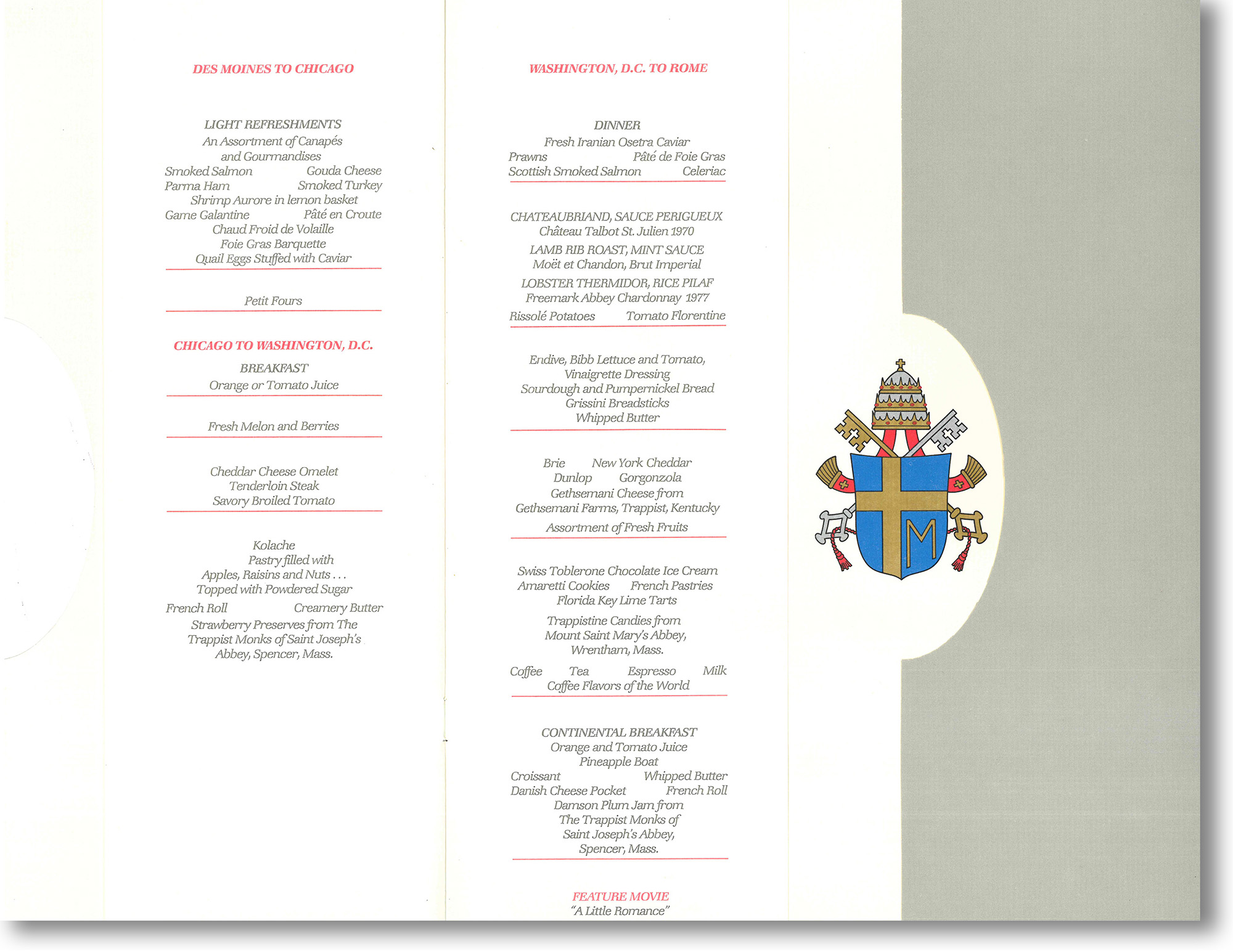
Papal Airline Menu by Trans World Airline
Local entrepreneurs felt the draw of the Pope. The visit prompted an explosion of unlicensed merchandise offered to Chicagoans and tourists hungry for souvenirs (the Archdiocese cautiously distanced itself from any connection with these bootleg goods). Some business owners doubtless recognized the prestige that came from catering to the leader of the Catholic Church.
During his visit, John Paul II stayed in the Archbishop’s Mansion on North Avenue. There, he enjoyed two separate dinners at the estate. The event was catered by the personnel of the Drake Hotel. Here are two recipes preserved from the dinner, One for an entrée and another for a dessert.
Still, other business owners, feeling fidelity towards Pope John Paul II and the Church, offered their services freely and spontaneously: wineries, bakeries, chauffeurs and more. Many of these offers, some sent directly to Cody, had to be turned down. Nonetheless, they attest to the sheer excitement and awe animating the archdiocese, whose residents rushed at their chance to be part of the big day. Walter Kuczak owned a small Polish delicatessen on 6247 N. Milwaukee Ave. Feeling a common bond with the Pope’s Polish roots, he offered a sampling of his deli’s sausages to the Cardinal and Holy Father. His letter is imbued with both pride and patriotism. This letter came with hand-written instructions on how to prepare the sausages into various polish dishes.
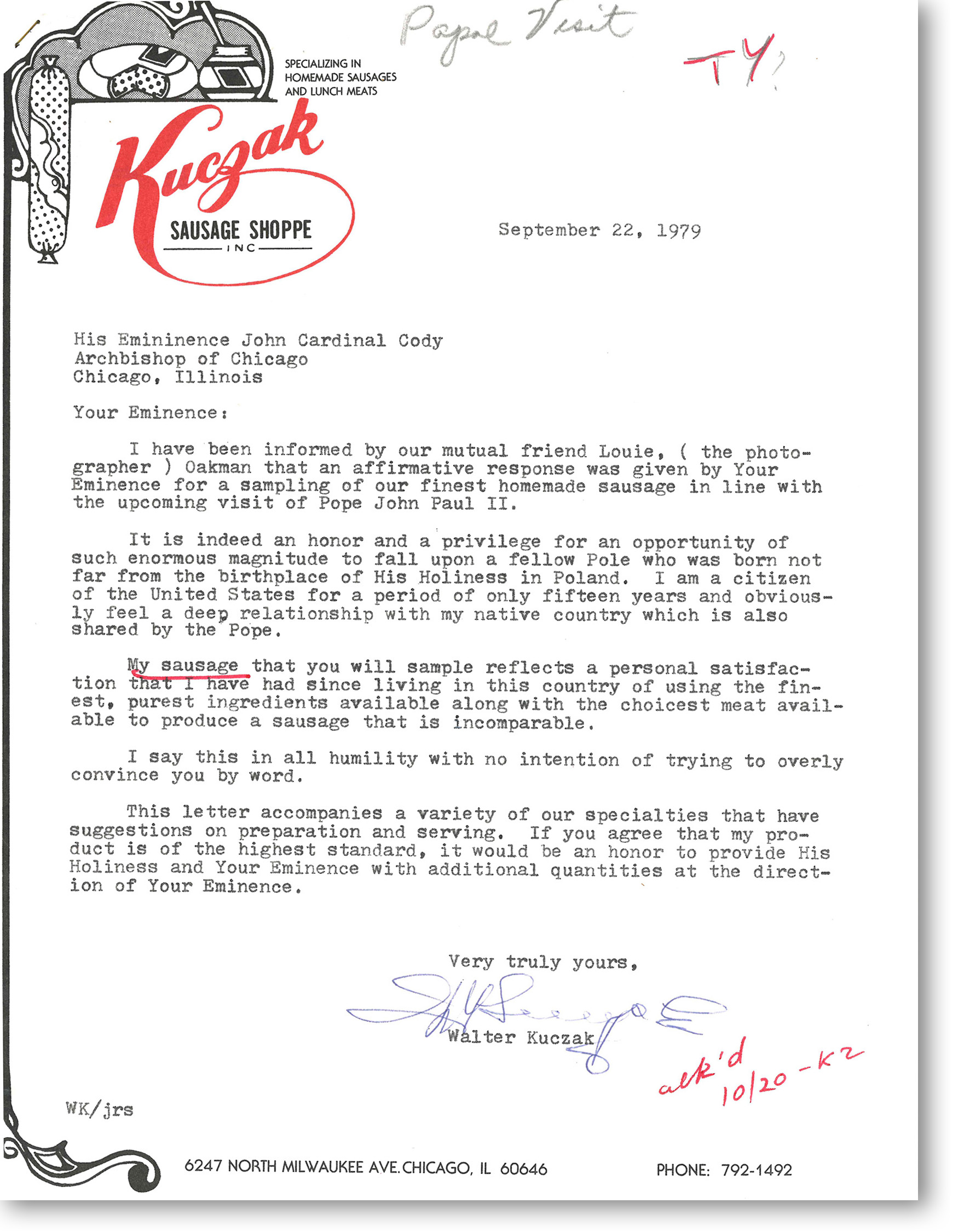

Letter from Walter Kuczak to Cardinal Cody, 1979 Handwritten Note

Gast granite slab
To commemorate Pope John Paul II’s stay at the Archbishop’s Mansion, longtime Chicago headstone makers Gast Monuments fashioned a black granite slab with the likeness of the pope on it, presenting it to the Archdiocese. The portrait was sketched by the Italian-born granite artist Alcide Fantoni. Cody wrote to Bert Gast, stating:
“As of yesterday, this plaque has been embedded in the brick wall in the entrance to my residence and it will remain there forever to attest the signal honor that we had in entertaining Pope John Paul II… It was embedded in the brick wall so there is no danger of its removal. As is written on many monuments in the Eternal City – “ad futuram rei memoriam” – this plaque will attest the presence of Pope John Paul II in our city as well as the skill of the sculptor and the generosity of your own good selves.”
Cardinal Cody to Bert Gast and Family, July 25, 1980
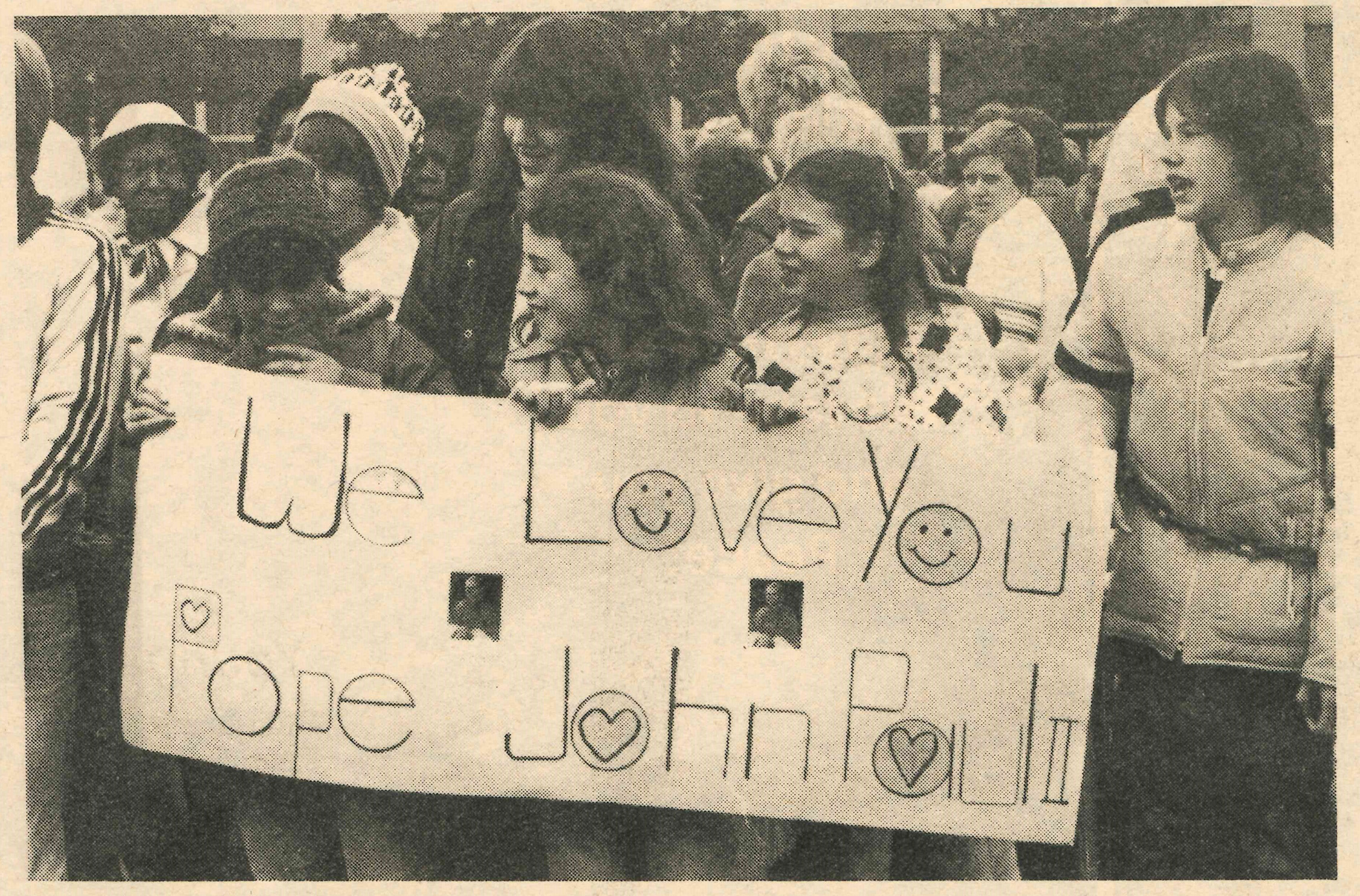
After his arrival at O’Hare, the Pope’s motorcade paraded through the Northwest Side, with crowds thronging both sides of Milwaukee Avenue. The next day, the first stop was Providence of God in the Pilsen neighborhood, where the Hispanic community came out in full force to meet Juan Pablo Segundo. For Pilsen residents, it was more than just an opportunity to see the vicar of Christ. It was also an opportunity to shed light on their struggles with poverty and inequality. John Paul II praised the work done by the Campaign for Human Development, an initiative started by the United States Conference of Catholic Bishops (USCCB) to alleviate poverty and foster community in urban neighborhoods.

John Paul II outside of Providence of God, 1979. From the Chicago Catholic.
“…what we saw when he arrived was something I won’t forget. He was a human being. His cassock was wrinkled. There was no golden aura, no clouds to surround him. When he looked at me, I saw a serene face filled with confidence, and I found myself practically crying. … If you asked me what I got out of the visit, I’d have to say that it was a tremendous boon to my hopes. It was like making a good retreat. I want to see him again.”
Fr. James Colleran, speaking to the Chicago Catholic, 1979
After leaving Pilsen, John Paul II’s retinue turned towards the Polish community. Wojtyla had a special status among the world’s Poles, in no small part due to his role as a symbol of Polish resistance to Soviet communism. Not long after announcing the trip, the Pope notified the archdiocese that a special mass would take place on behalf of all Poles—in Polish—at Five Holy Martyrs, where he had visited twice before.
At this mass, the Pope asked the crowd to “place on this altar an offering of everything you—the American Polonia, have represented from the very beginning, from the time of Kosciuszko and Pulaski…” By referencing the two Revolutionary War heroes, John Paul insisted that the Polish-American community was foundational to the nation.

Bishop Alfred Abramowicz presenting John Paul with honorary street sign. Bishop Abramowicz was a well-known advocate for Polish Catholics during the Communist regime.
John Paul II’s next stop on was Quigley Preparatory Seminary South on S. Western Ave. According to rumors among former Quigley staff and students, influential Vatican official (and Quigley South graduate) Paul Cardinal Marcinkus persuaded the Pope to add the high-school seminary to his itinerary. The Pope made the most of his time at Quigley: John Paul II made no less than three public addresses and held a meeting with the USCCB!
Students from all archdiocesan seminaries were invited: Quigley North, Quigley South, Niles College, and University of St. Mary of the Lake. Like many other facets of the Papal Visit, timing was strict. One Quigley alumnus ruefully recalled how he arrived at school 15 minutes late; security did not allow him to enter the school with his classmates. He had to make do with being one of the thousands gathered outside Quigley South.

From the Chicago Catholic.
After greeting the rector, Fr. Gerald Kicanas, the Pope met the other faculty and staff. Former teacher Fr. Louis Zake recalls how he bumped into the Pope quite by accident in the school auditorium; to his surprise, he was able to exchange pleasantries with John Paul II in Polish before he left to prepare for a short prayer service with the over 370 bishops assembled there.
These photographs highlight the gifts given to the Pope by Quigley’s seminarians. They included a soccer ball—the pope’s favorite sport—and a ski hat, as Wojtyla was an avid mountaineer and skier.
Addressing the seminarians, John Paul II encouraged the development of their vocations, saying they should “nourish their spirits daily” with the Eucharist.
Turning his attention to the USCCB, the Holy Father reaffirmed church teaching on the priestly celibacy and Pope Paul VI’s encyclical Humanae Vitae. Stressing their roles as spiritual leaders, the pope called for unity among the bishops and lauded the USCCB’s efforts at integrating Christian life into American society, stating:
“I praise your rejection of racial antagonism…the oppression of the weak, the manipulation of the vulnerable, the waste of goods and resources, the ceaseless preparations for war, unjust social structures and policies, and all crimes by and against individuals and against creation.”
Pope John Paul II, to the USCCB, 1979
Pope John Paul II’s visit is most remembered for its mass in Grant Park. It was the largest mass ever celebrated in Chicago, with local media estimating at least 200,000 people in attendance inside the park itself. Those visiting from outside the city arrived by all means possible: public transportation, carpooling, and by the busload. Some walked from their hotel rooms to the mass, while others spent the entire night in Grant Park awaiting the arrival of the Holy Father to secure their place for the ceremony.
Maeve Stephenson awaits the arrival of the pope at Grant Park. From the Chicago Catholic.

Chicago Transit Authority Ticket for Papal Visit, 1979. The Chicago Transit Authority issued a special pass on the day of the Papal Mass, allowing free rides and transfers for anyone wishing to catch a sight of the Pope.
The Altar used during the Grant Park Mass had to be especially built for the event, at the cost of over $200,000. Fox and Fox Architects designed the massive, tiered sanctuary with the Holy Father’s chair resting on the highest point of the structure, directly across from the altar. The altar also had designated seating for the cardinals and bishops of the Church. On display are two scans from the final architectural drafts prior to the altar’s construction.

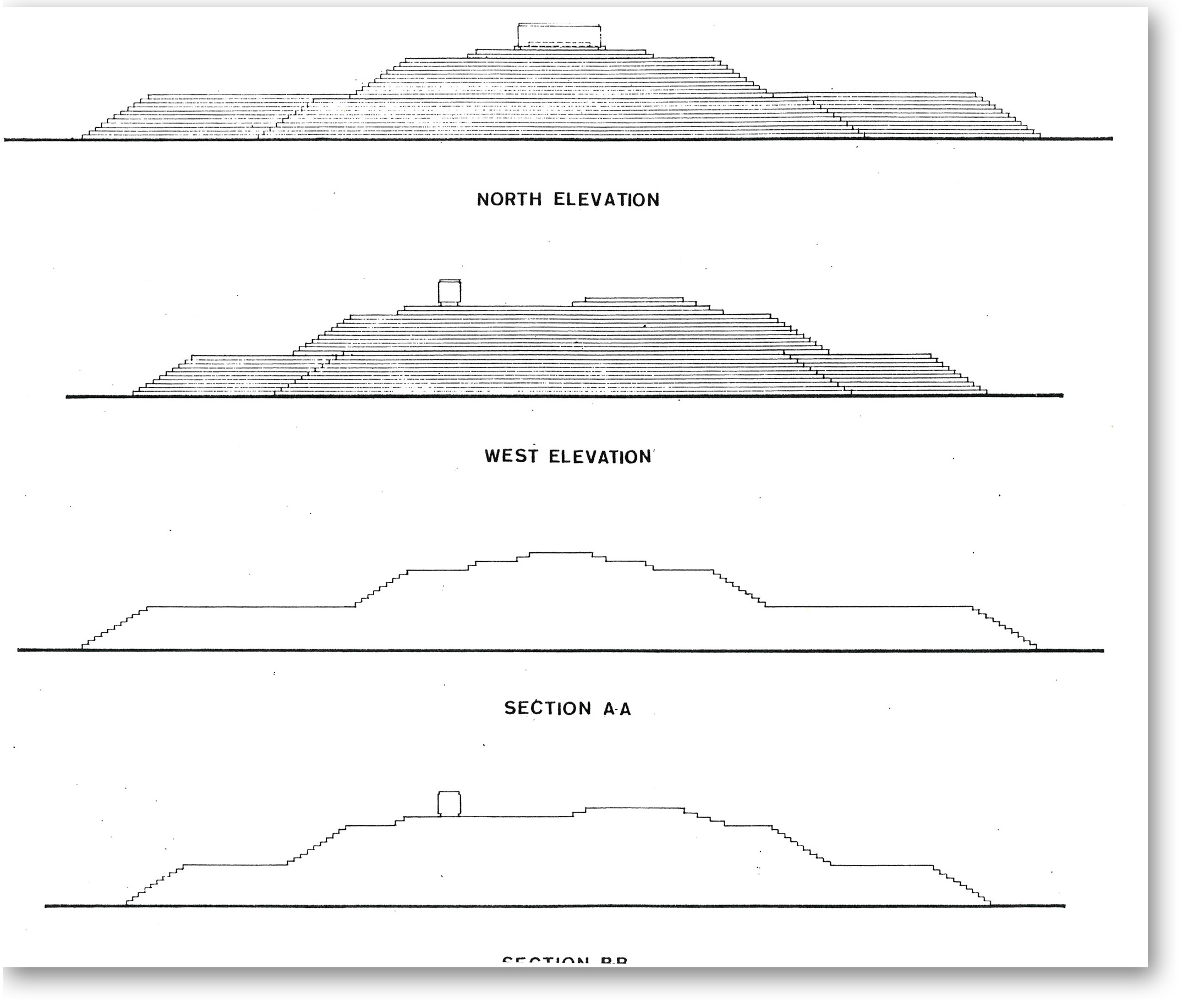
This illustrated map of Grant Park was distributed to Archdiocese officials and personnel attending the mass. The map highlights both points of interest as well as necessities throughout the park. With hundreds of thousands of people in attendance, this map underscores the coordinated effort from city, church, and medical officials to ensure the safety of all attendees.
Grant Park
Buckingham fountain set a lively backdrop to the ceremony, accenting an altar surrounded with bright yellow mums. The Holy Father gave Communion to one hundred and fifty separate people selected from the 6 vicariates of the Archdiocese of Chicago, while over 600 priests and deacons administered the Eucharist to the crowds below.
Pope John Paul II focused the themes of his Mass around the idea of evangelization and unity. The committee in charge of finding participants for the Papal Mass threw out a general call throughout the Archdiocese, asking parishes to recommend members who exemplified the Church’s mission of evangelization. One such participant was Josephine Evans of St. Pascal Parish, who collected the memorabilia of that fateful day in a scrapbook page, seen here. Josephine was selected to be one of the laywomen to bring up the gifts for the altar to the Holy Father, pictured below.
Josephine Evans scrapbook. Mrs. Evans’ scrapbook contains stamps, the mass booklet, her CTA ticket, and her ticket for admittance to the altar at Grant Park.

Josephine Evans giving gifts to the Pope
Prior to the mass the Pope directed the Rite of Initiation, leading several individuals who had been studying to become Catholics. Pictured here is Cardinal Cody overseeing the catechumens, and a sample of the mass program from their initiation.
The feeling of the mass was best described by the pope in his homily saying,
“Looking at you, I see a people who thrown their destinies together and now write a common history…your unity as members of the People of God.”
The Pope’s visit to the city of Big Shoulders lasted only 40 hours. Despite this short time, it was an event so powerful that it brought together the entire city. Beyond the allure of celebrity, the pope's presence gave Catholics a very real connection to their faith and the larger world of the Universal Church. John Paul II's visit to Chicago elevated the stature of the Archdiocese, yes—playing host to a pope necessarily conveys a certain prestige—but more importantly, it affirmed and made meaningful the faith and aspirations of its people. In an unprecedented way, the Papal Visit made Chicagoans reflect together on their faith and spirituality.
Some of this reflection was cultivated by the Archdiocese. The planning committee wanted a family at the Papal Mass to represent all families in the Archdiocese. To this end, they ran an essay contest with the simple question: “What spiritual benefit do you think your family would derive from attendance at the Papal Mass?” Out of the dozens and dozens of essays, the committee chose Mrs. Mildred Tahany’s impassioned response, reproduced here:

Copy of Mildred Tahany’s winning essay reproduced for the Planning Committee
The Catholic schools of the Archdiocese encouraged students to create welcome albums for the pope. These took the form of scrapbooks from each vicariate. Inside, the students detailed their interests, what they liked about their schools, and how excited they were to see the Pope. By asking its participants what made their Catholic school special to them, the albums served as consciousness-raising exercise for both student and teacher alike.
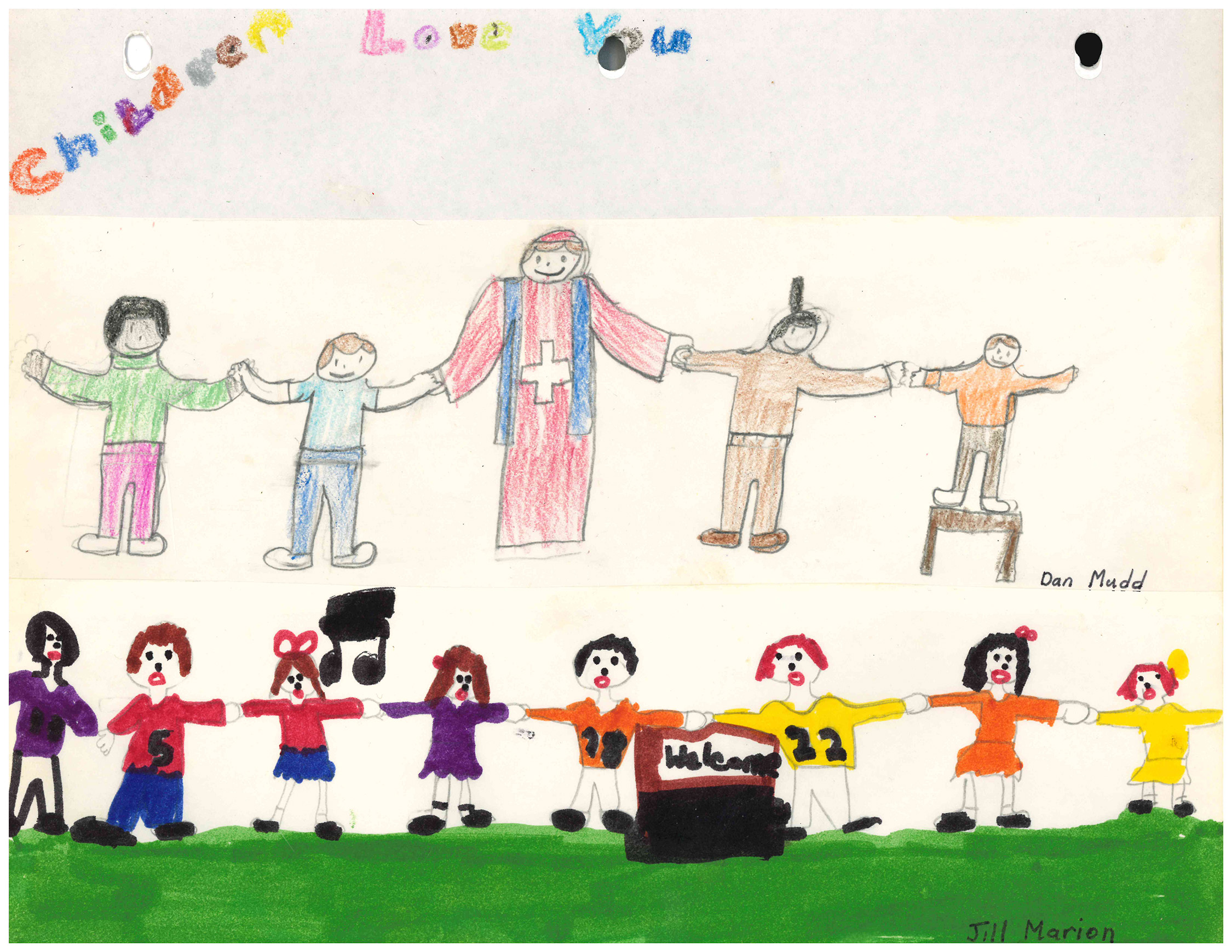
This scrapbook page came from St. Joseph’s school in Libertyville.
Those lucky enough to attend the Grant Park mass recognized its significance. Being part of the Papal Mass was a source pride and not only for the participant, but their whole family. This letter to Cardinal Cody from the Podrazik family—whose daughter Paula received communion from the Pope—illustrates how the event imprinted itself in different ways: spiritually, locally, nationally, and more.
Encountering the Pope provided wonder and excitement, as many of the photos in this exhibit attest. However, the encounter also provided Chicago Catholics with an infusion of spiritual energy. The opportunity to reflect on their own lives and faith in the context of John Paul’s visit gave validation to their longing and aspirations. It was like an infusion of spiritual energy.
The myriad requests, petitions, and offers demonstrate the full range of this aspiration: A Polish man writing to Cody asked that he and the Pope stop by his 81-year-old mother's house for a proper home-cooked Polish meal. Another wrote a letter on behalf of his dying friend, Jack Thum the Clown—a local entertainer who spent his life caring for orphaned children—hoping the pope could offer him a final blessing. A sense of self-worth permeates these letters. Paraphrasing the pope’s remarks at Quigley, they were important because the Pope came to see them.
One woman’s card to Cardinal Cody encapsulates this feeling. In it, she talks about how she was moved John Paul II’s encounter with a visiting handicapped boy, exclaiming that “God was in our midst!”

Mary Schweiger’s card to Cardinal Cody. The boy mentioned here is Bobby Lujano, who lost his limbs to a rare disease at the age of 9. Bobby would later go on to be a Paralympic bronze medalist.
Even if John Paul II could not meet, speak, or bless everyone, the Catholics of Chicago felt uplifted by his attention and consideration. Whether a business owner or student, curious onlooker or believer, all of Chicago could for a little while in the fall of 1979 claim the attention of the Pope and felt the eyes of the Church on them, believing that God was in their midst.
Researched and Written by Charles Heinrich and Jose “Jojo” Galvan. Charles received his MA in History from Loyola University Chicago in 2015 and is an Archival Technician at the Joseph Cardinal Bernardin Archives and Records Center. Jojo Galvan earned his BA in History and Religious Studies from North Central College in Naperville, IL in 2019. He is a graduate student at the University of Illinois in Chicago, pursuing an MA in Museum and Exhibition Studies. Jojo was an archival intern during the summer of 2019 at the Archives and Records Center.
Administrative Records - Subject Files - Roache, Rev. James P. ADMN/S8100/574 Joseph
Cardinal Bernardin Archives and Records Center, Archdiocese of Chicago, Chicago, IL.
Historical Records - Pope John Paul II’s Visit to Chicago HIST/H3300/379. Joseph Cardinal Bernardin Archives and Records Center, Archdiocese of Chicago, Chicago, IL.
History Records – Scrapbook - Council I Schools Lake County, Illinois Welcome Pope John Paul II. HIST/S1000/63. Joseph Cardinal Bernardin Archives and Records Center, Archdiocese of Chicago, Chicago, IL.
“175th anniversary: 1979 visit by John Paul II key part of Chicago history,” Chicago Catholic, November 8, 2018. https://www.chicagocatholic.com/chicagoland/-/article/2018/11/08/1979-visit-by-john-paul-ii-key-part-of-chicago-histo-1 (Accessed August 2019).
“News about BGA Members,” Barre Life, Barre Granite Association, Summer 1980.
The Chicago Catholic: Souvenir Edition, Vol. 87, No. 41, October 12, 1979, Chicago, Illinois.
The Pope in Chicago: Commemorative Album. Chicago: Follett Publishing Company, 1979.
Five Holy Martyrs Diamond Jubilee. Chicago: King Co. Publishing, 1984.
Quigley Preparatory Seminary North, Le Petit Seminaire. Chicago: 1980.
Quigley Preparatory Seminary South, ΙΧΘΥΣ. Chicago: 1980.
Benzkoffer, Stephan. “When the pope came to Chicago,” Chicago Tribune, October 4, 2014. https://www.chicagotribune.com/news/ct-per-pope-visits-chicago-flashback-1005-jm-20141005-story.html (Accessed September 2019).
Boston Globe, Chicago Sun-Times, et al. The Pope in America. Indianapolis: Features Press, 1979.
Moran, Dan. “Pope’s Visit elicits memories of John Paul II’s 1979 visit to Chicago,” Lake-Sun, September 25, 2015. https://www.chicagotribune.com/suburbs/lake-county-news-sun/opinion/ct-lns-moran-pope-visit-st-0926-20150925-story.html (Accessed September 2019).
Sawyer, Kathy. “Pope Will Not Relax Ban on Marriage for Priests,” Washington Post, October 5, 1979. https://www.washingtonpost.com/archive/politics/1979/10/05/pope-will-not-relax-ban-on-marriage-for-priests/27552dab-a636-4961-8a22-d386950fd415/ (Accessed September 2019).